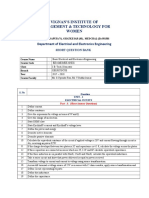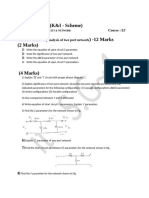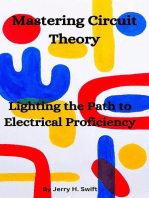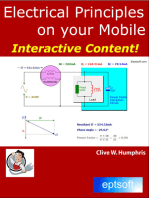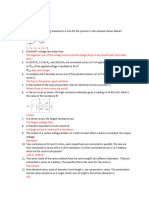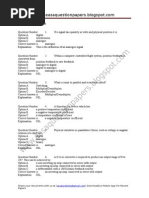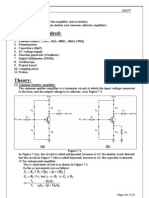BEE Viva Questions
BEE Viva Questions
Uploaded by
bobadrink45Copyright:
Available Formats
BEE Viva Questions
BEE Viva Questions
Uploaded by
bobadrink45Copyright
Available Formats
Share this document
Did you find this document useful?
Is this content inappropriate?
Copyright:
Available Formats
BEE Viva Questions
BEE Viva Questions
Uploaded by
bobadrink45Copyright:
Available Formats
Dear Students,
I have compiled a set of sample questions to provide you with an idea of the
types of questions that may be asked during the BEE (Basic Electrical
Engineering) viva. It's crucial to note that these are illustrative questions, and
the actual viva may include questions covering the entire BEE syllabus,
both theoretical and practical. Examiners have the flexibility to formulate
their own set of questions, so it's essential to be well-versed in all aspects of the
subject matter. Consider these sample questions as a helpful guide, but be
prepared for a diverse range of questions that reflect the comprehensive scope
of the BEE syllabus.
Dr. A. B. Patil
BEE Sample Viva Questions
Examiner can ask students
o To identify components such as resistor, capacitor, and inductor,
and determine their values using colour bands / printed values.
o To measure the values of resistors using Multimeter.
o To set up series and/or parallel resistor network on breadboard.
How does a practical (voltage/current) source differ from an ideal
(voltage/current) source?
Describe the process of transforming a voltage source into an equivalent
current source.
Define terms: Node, Junction, Loop, Mesh
Examiner can give a network and ask student to find equivalent resistor
(to test concepts of series-parallel reduction technique, star-delta
conversion, short circuit and open circuit).
What is Kirchhoff's Current Law, and how is it applied in a circuit?
Explain Kirchhoff's Voltage Law and provide an example of its
application.
Examiner can give a network and ask student to write KCL and / or KVL
equations
State and Explain (Thevenin's / Norton’s / Superposition / Maximum
Power Transfer) theorem
Draw the Thevenin's / Norton’s equivalent circuit
How is the Thevenin equivalent voltage / Norton equivalent current
determined in a circuit?
What is the Thevenin equivalent / Norton equivalent resistance, and how
is it calculated theoretically and practically?
Describe the experimental setup used to verify the Thevenin's / Norton’s
/ Superposition Theorem.
Define the following terms related to alternating quantities: Waveform,
Cycle, Frequency, Time period, Form factor, Peak factor.
Define rms value, average value and amplitude related to alternating
quantities. Which of these values are recorded by ammeters and
voltmeters?
What is Phase Difference? Draw two sinusoidal waveforms Va and Vb
showing (i)Va and Vb in phase, (ii) Va leading, (iii) Va lagging.
Give rms value and average value for v = Vm sin θ.
An alternating voltage is represented by v = 141.4 sin 314t. Find (i) max-
value (ii) rms value, (iii) average value, (iv) frequency, (v) time period and
(vi) form factor.
Draw voltage and current waveforms for each of the following circuits (i)
Purely resistive circuit, (ii) Purely inductive circuit, (iii) Purely capacitive
circuit, (iv) series RL circuit and (v) series RC circuit.
Draw phasor diagrams for each of the following circuits (i) Purely
resistive circuit, (ii) Purely inductive circuit, (iii) Purely capacitive circuit,
(iv) series RL circuit and (v) series RC circuit.
What is impedance for each of the following circuits (i) Purely resistive
circuit, (ii) Purely inductive circuit, (iii) Purely capacitive circuit?
State phase difference between voltage and current for each of the
following circuits (i) Purely resistive circuit, (ii) Purely inductive circuit,
(iii) Purely capacitive circuit, (iv) series RL circuit and (v) series RC
circuit.
What is the power factor for each of the following circuits (i) Purely
resistive circuit, (ii) Purely inductive circuit, (iii) Purely capacitive circuit
Draw the phasor diagram and voltage triangle for (i) series RL circuit and
(ii) series RC circuit
Define reactive power.
State formulae and units for active power, reactive power and apparent
power.
For the supply voltage v = Vm sin ωt, write current expression for each of
the (i) Purely resistive circuit, (ii) Purely inductive circuit, (iii) Purely
capacitive circuit, (iv) series RL circuit and (v) series RC circuit, if the
voltage expression
Draw phasor diagrams for RLC series circuit for (i) XL > XC and (ii) XC >
XL
Draw voltage and current waveforms for RLC series circuit for (i) XL > XC
and (ii) XC > XL
What is the necessary condition for resonance in series circuit?
Derive the expression for resonance frequency for (i) series RLC circuit
and (ii) parallel RLC circuit.
What is the power factor of an RLC circuit at resonance, and why does it
exhibit this particular value?
Compare series and parallel resonance.
What is need of resistance in series resonance circuit?
Why power factor is leading in series circuit before resonance.
Define phase voltage, phase current, line voltage and line current
State the relationship between phase voltage and line voltage, line
current and phase current in delta and star network.
You might also like
- Basic Electrical AssignmentDocument7 pagesBasic Electrical AssignmentMATHANKUMAR.SNo ratings yet
- Double Tail ComparatorDocument32 pagesDouble Tail ComparatormdlogicsolutionsNo ratings yet
- Electrical Circuits Question BankDocument18 pagesElectrical Circuits Question BankRacherla Mega RaniNo ratings yet
- 1.1 Describe Generation of A Single Phase Sinusoidal Alternating CurrentDocument13 pages1.1 Describe Generation of A Single Phase Sinusoidal Alternating CurrentMathew Pak Yu CheungNo ratings yet
- BEEE Topics For ETEDocument3 pagesBEEE Topics For ETEtannuNo ratings yet
- BEE New Important QuestionsDocument9 pagesBEE New Important Questionsaraq3501No ratings yet
- Common Course BrainStorming Questions FinallDocument107 pagesCommon Course BrainStorming Questions Finallassefag92No ratings yet
- B.E./E.Tech. D E G R E E Examination, April / May 2011Document2 pagesB.E./E.Tech. D E G R E E Examination, April / May 2011Ramkumar SivakaminathanNo ratings yet
- Bee Model Questions 18ele23Document3 pagesBee Model Questions 18ele23darcyNo ratings yet
- Electrical Circuit Analysis (20A02301T) : Lecture NotesDocument271 pagesElectrical Circuit Analysis (20A02301T) : Lecture Notestharunrathod99No ratings yet
- Electrical Circuit - 2Document35 pagesElectrical Circuit - 2arnabruet2004No ratings yet
- Beee Unit - 1Document8 pagesBeee Unit - 1Pradeev BalakrishnanNo ratings yet
- Class 03Document76 pagesClass 03miguel angel camargo chevelNo ratings yet
- Lecture 5 and 6 Mist SpecialDocument26 pagesLecture 5 and 6 Mist SpecialGaffar KhanNo ratings yet
- ECA-I Short Answer QuestionsDocument7 pagesECA-I Short Answer QuestionspadmalalithaNo ratings yet
- WWW Universityquestions inDocument63 pagesWWW Universityquestions inRajgir Raj100% (1)
- BEE QBDocument2 pagesBEE QBShubham PatilNo ratings yet
- Laboratory Manual For Ac Electrical CircuitsDocument81 pagesLaboratory Manual For Ac Electrical CircuitsanupvasuNo ratings yet
- BEEE NotesDocument8 pagesBEEE NotesSrinathReddyNo ratings yet
- ISC_XII_PHYSICS_ QB.(1)Document11 pagesISC_XII_PHYSICS_ QB.(1)mvibe725zNo ratings yet
- Current ElectricityDocument4 pagesCurrent ElectricitywilsoncruellaNo ratings yet
- Beee (R 17) Short Question Bank 2017Document4 pagesBeee (R 17) Short Question Bank 2017upender raoNo ratings yet
- QB KEE101T ElectricalDocument15 pagesQB KEE101T Electricalplantforest16No ratings yet
- Laboratory Manual For Ac Electrical CircuitsDocument75 pagesLaboratory Manual For Ac Electrical CircuitsArnulfo LavaresNo ratings yet
- Basic Electrical and Electronics Engineering (BEEE) (I Year I Sem) Unit - I Short QuestionsDocument4 pagesBasic Electrical and Electronics Engineering (BEEE) (I Year I Sem) Unit - I Short Questionsmonika0404No ratings yet
- Unit 1 2marksDocument6 pagesUnit 1 2marksKannan TindivanamNo ratings yet
- Instructions: Q. No. 1 To 4 (One Mark Each), Q. No. 5 (2marks), Q.No.6 (4 Marks) 7 To 12 (5 Marks Each)Document1 pageInstructions: Q. No. 1 To 4 (One Mark Each), Q. No. 5 (2marks), Q.No.6 (4 Marks) 7 To 12 (5 Marks Each)Sen KumarNo ratings yet
- Fy Bee Suk Qb Nep2.0Document3 pagesFy Bee Suk Qb Nep2.0aratipatil3478No ratings yet
- 12th Physics Worksheet (ch3 To ch7)Document3 pages12th Physics Worksheet (ch3 To ch7)lovecatsaninalsNo ratings yet
- II PUC Physics Important QuestionsDocument4 pagesII PUC Physics Important Questionsphysicskn92No ratings yet
- Question BankDocument45 pagesQuestion BankSaritha Reddy100% (1)
- Circuit Fundamentals and Circuit TheoryDocument8 pagesCircuit Fundamentals and Circuit TheoryዮናስNo ratings yet
- Basic Electrical Questions Bank-2023Document8 pagesBasic Electrical Questions Bank-2023lalitesh050No ratings yet
- U-2 BeeeDocument63 pagesU-2 Beeeharshdeep676747No ratings yet
- BEE Question Bank With AnswersDocument11 pagesBEE Question Bank With AnswersSyed UmarNo ratings yet
- Circuit Analysis and Design Manual FinalDocument65 pagesCircuit Analysis and Design Manual Finalصدام حسینNo ratings yet
- Theory Question BankDocument3 pagesTheory Question BankSiddhartha DasNo ratings yet
- Gjc - 1 - Physics Technology Jss 3. - EditedDocument29 pagesGjc - 1 - Physics Technology Jss 3. - Editedpalmer okiemuteNo ratings yet
- ELECTRIC CIRCUIT MODULE 1Document84 pagesELECTRIC CIRCUIT MODULE 1mahlatsekekana42No ratings yet
- Basic Electrical and Electronics - Question Bank With AnswerDocument93 pagesBasic Electrical and Electronics - Question Bank With Answerharish.m.2024.aimlNo ratings yet
- EE209 Experiment 4Document4 pagesEE209 Experiment 4Greed RvYNo ratings yet
- BE 3251 BEEE QB ANSWERS-2-64Document63 pagesBE 3251 BEEE QB ANSWERS-2-64I SaraswathiNo ratings yet
- CURRENT ELECTRICITYDocument6 pagesCURRENT ELECTRICITYmili groupNo ratings yet
- Laboratory Manual For Ac Electrical CircuitsDocument90 pagesLaboratory Manual For Ac Electrical CircuitsLharie Mae BecinaNo ratings yet
- Laboratory Manual For Ac Electrical CircuitsDocument78 pagesLaboratory Manual For Ac Electrical CircuitsTammanurRaviNo ratings yet
- Detection Ferro Resonance OccurrenceDocument17 pagesDetection Ferro Resonance OccurrenceMario Mañana CanteliNo ratings yet
- 1basic Electrical Engineering Lab 2020-21Document82 pages1basic Electrical Engineering Lab 2020-21roberto carlos roberto carlosNo ratings yet
- Experiment Guide For RC Circuits 1. CapacitorsDocument9 pagesExperiment Guide For RC Circuits 1. CapacitorsShafiqul Islam ShafiqNo ratings yet
- it's S.G~1Document5 pagesit's S.G~1Sumit GungeNo ratings yet
- Fundamentals of Electricity and Electronics: Dr. Abdullah Yahia AlamriDocument58 pagesFundamentals of Electricity and Electronics: Dr. Abdullah Yahia AlamriAli Al-NahariNo ratings yet
- Question Bank BeeDocument25 pagesQuestion Bank Beedhruv goraiNo ratings yet
- Electric CircuitsDocument107 pagesElectric CircuitsKristine Cris VenusNo ratings yet
- Question Bank With Answers: BE 8253 - Basic Electrical, Electronics and Instrumentation EngineeringDocument93 pagesQuestion Bank With Answers: BE 8253 - Basic Electrical, Electronics and Instrumentation EngineeringRajeshNo ratings yet
- Class Session FileDocument5 pagesClass Session FileLara MaxNo ratings yet
- Be-104 (Beee)Document69 pagesBe-104 (Beee)Sunil NamdevNo ratings yet
- Electrical Circuits & Networks Question BankDocument6 pagesElectrical Circuits & Networks Question BankMATHANKUMAR.S100% (1)
- Chapter 2 Det10013Document15 pagesChapter 2 Det10013che syakirNo ratings yet
- VX-2100 2200 VHF EuDocument68 pagesVX-2100 2200 VHF EudenariraNo ratings yet
- Review Exam ELEC Questions and AnswersDocument27 pagesReview Exam ELEC Questions and AnswersheelchristianNo ratings yet
- Module 05 Part 2Document20 pagesModule 05 Part 2Aviation WorldNo ratings yet
- Integrated CircuitDocument5 pagesIntegrated Circuiturwah dzNo ratings yet
- Uni-Semi-U3115s C400130Document9 pagesUni-Semi-U3115s C400130Emanuel SantilloNo ratings yet
- X1M Agc ManualDocument7 pagesX1M Agc ManualapsNo ratings yet
- CMOS Amplifiers - Problems PDFDocument20 pagesCMOS Amplifiers - Problems PDFAnurag Anand100% (1)
- EE3408E Project Design A Two-Stage Operational AmplifierDocument4 pagesEE3408E Project Design A Two-Stage Operational AmplifierLaSo ASNo ratings yet
- Modern QRP Rigs and The Development of The QCX CW Transceiver KitDocument36 pagesModern QRP Rigs and The Development of The QCX CW Transceiver KitChandrashekhar KulkarniNo ratings yet
- ECT AssignmnetDocument18 pagesECT AssignmnetJayanthiKathiresanNo ratings yet
- HSDL 3005 028Document28 pagesHSDL 3005 028ph_lopsNo ratings yet
- Basic Laws of Electric Circuits: Nodal AnalysisDocument29 pagesBasic Laws of Electric Circuits: Nodal AnalysisLeila CheropNo ratings yet
- Akai MPC 2000 XL SchematicDocument4 pagesAkai MPC 2000 XL SchematicStanley HervéNo ratings yet
- DIY - Change Car ChargerDocument6 pagesDIY - Change Car ChargerHans HamiltonNo ratings yet
- Transistor As An Amplifier: S BB CCDocument3 pagesTransistor As An Amplifier: S BB CCsreelakshmi.ece eceNo ratings yet
- VLSI Design Syllabus - 2018 SchemeDocument2 pagesVLSI Design Syllabus - 2018 SchemeShivansh BhartiNo ratings yet
- ECE131 Unit4 Part 2Document79 pagesECE131 Unit4 Part 2Vana PraveenNo ratings yet
- Transient Analysis MaterialsDocument17 pagesTransient Analysis MaterialsWitchayut SudthanyaratNo ratings yet
- EEE312 - Midterm Exam - Part 1 - Google FormsDocument4 pagesEEE312 - Midterm Exam - Part 1 - Google FormsDavid Louie BediaNo ratings yet
- Darligton Emmiter Follower ExpDocument3 pagesDarligton Emmiter Follower ExpSharanbasappa BelamgiNo ratings yet
- IC 741 Operational AmplifierDocument8 pagesIC 741 Operational AmplifierJed PeriaNo ratings yet
- Kirchoff 00002Document25 pagesKirchoff 00002Ellen Kay CacatianNo ratings yet
- MM 74 C 912 NDocument8 pagesMM 74 C 912 NsuriantoNo ratings yet
- Common Emitter and Common Collector AmplifiersDocument7 pagesCommon Emitter and Common Collector Amplifiersabdullah samdi89% (9)
- Network Analysis and SynthesisDocument1 pageNetwork Analysis and Synthesisbrijeshkumar30596No ratings yet
- Motorola GM Series ControllerDocument26 pagesMotorola GM Series ControllerBảo Bình100% (1)
- Current-Mode: An Overview: J-F Perotto, CSEM & EICNDocument18 pagesCurrent-Mode: An Overview: J-F Perotto, CSEM & EICNปรัชญาภรณ์ สิงหนาทNo ratings yet
- CS302 Short QS SolvedDocument12 pagesCS302 Short QS SolvedattiqueNo ratings yet





















